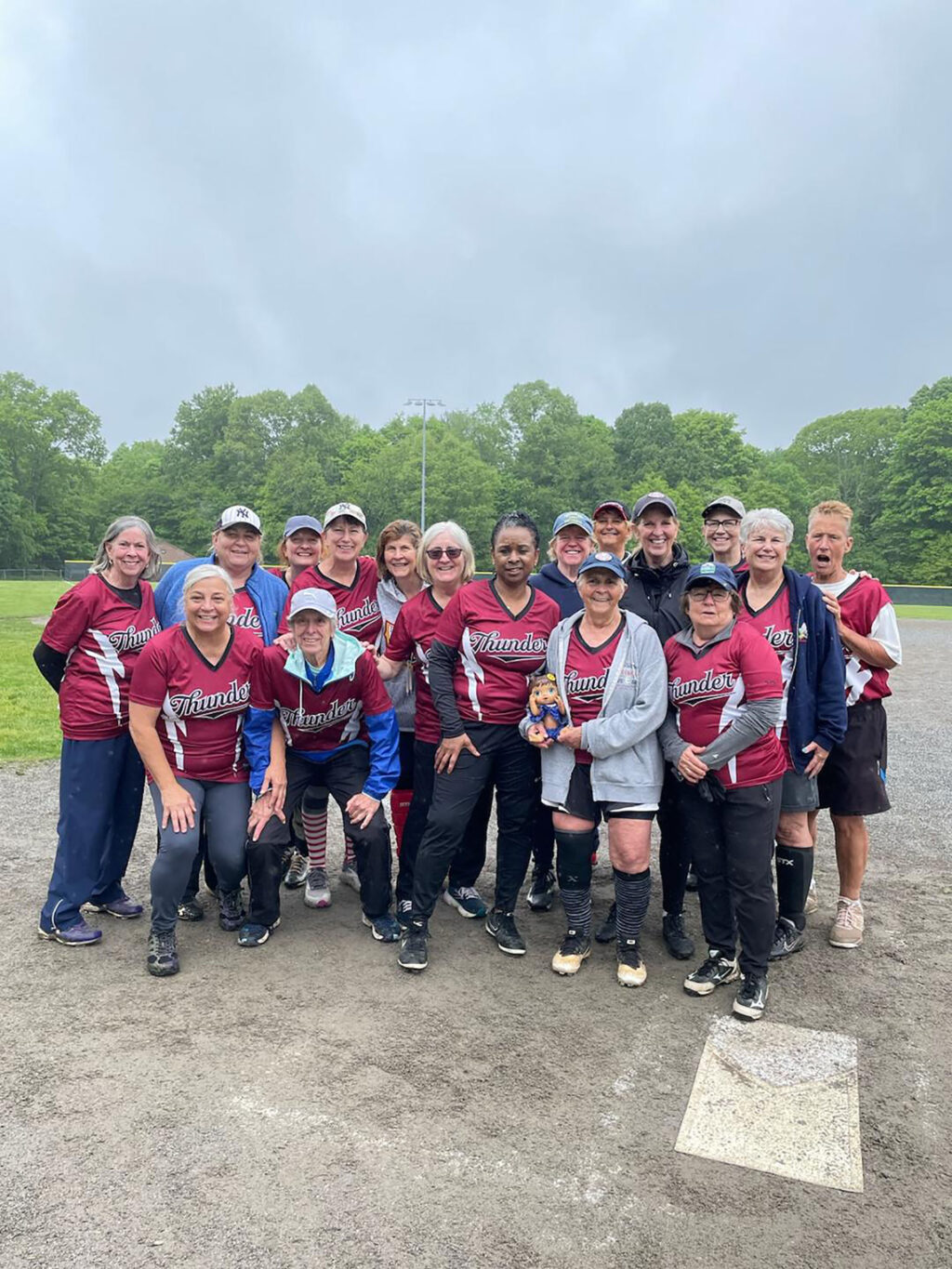By Andrew Kelsey
As we age, exercise can become more difficult as a result of everything from increasingly busy schedules to aging bodies breaking down. Exercise is also important for health reasons. Adult sports leagues are one way for men and women in their 20s or 30s on up into their 70s and beyond to keep active.
Preventing injury is essential. There are ways to at least cut down on the risk of injuries. And recovering from injury is also important for aging athletes who want to stay in the game.
Exercise is great for physical and mental health alike, notes Dr. Jeff Brown, a sports medicine specialist at Trinity Health Of New England’s Saint Francis Hospital and Medical Center in Hartford (part of the Connecticut Sports Medicine Institute). Dr. Brown is also a team physician at Central Connecticut State University, lead team physician for the Hartford Athletic soccer team, and supervising team physician for all nine Hartford public high schools.
A key part of engaging in physical activities is warming up. “Dynamic warmup before physical activity is really critical,” Dr. Brown notes, adding that stretching after workouts is best.
He suggests for those getting involved with sports or returning to play that they take it slowly initially and work their way up to longer increments. Crosstraining is a good way to stay in shape, mixing and matching walking, yoga or pilates, biking, or the elliptical machine, for example, Dr. Brown suggests.
For those who get injured, physical therapy is an important start to recovery. Once an athlete has graduated from physical therapy, they can start walking and working their way back to better fitness shape. Recovery can benefit from time in the water where athletes avoid the impact from running on the street or sidewalk.
“You have to be patient, listen to your body, not overdo it too quickly and get reinjured,” Dr. Brown adds.
In addition to proper warmup and cross-training to build muscles, good foot support can also be helpful. Dr. Brown has worked with a variety of athletes, including marathon runners from the Hartford Marathon Foundation’s League of Injured Runners.
Aging Athletically
“We’ve all heard the ‘age with grace’ adage,” says Dr. Robert Waskowitz, who serves as senior team physician for Central Connecticut State University (CCSU) and is the medical director for CCSU’s athletic training program. Instead, the mindset should be “age athletically,” he adds.
Dr. Waskowitz serves as a team consultant for many local and regional school systems. He is team physician for Newington High School and assists in covering Kingswood Oxford School athletics. In addition, he is one of the primary physicians covering the X-Games, providing onsite coverage as lead physician now in his 24th year.
“Three fundamentals that can provide the pillars to success are joint/whole body stretching, muscular maintenance with strengthening and core stability, and cardiovascular fitness,” states Dr. Wasakowitz.
Concerning dealing with prior injury, he suggests people know their limits and respect their body. “If it barks, listen. Two simple guidelines are heat to warm up and ice to cool down,” he explains.
Sport and activities of choice are critical in selecting the appropriate path to activity, Dr. Waskowitz notes.
“If you’re looking to start something new, find an appropriate group to introduce that specific activity. Your preseason is a necessity to increase cardio-fitness, flexibility and tone that will set you up for success; a gym, friend-group or personal trainer acts as the coach to get you where you want to be. Moderate to low impact activities (bike, swim, treadmill, hike, etc.) allow for initiating minimal risk activities,” Dr. Waskowitz said.
An Athletic Trainer’s Perspective
John Juniet, assistant athletic trainer at Albertus Magnus College, has several one-liners he keeps in mind when helping someone return to sport or physical activity after an injury or extended time off. “Time is an investment, use it wisely in your recovery and return process. Slow and steady wins the race. You cannot go from 0 to 60 in 10 feet; not even cars can do that. Remember to pay attention to what your body is telling you. Persistence is the key.”
Juniet points out that there’s a big difference for the average individual between a 20 something and a 50 something. The younger one, on average, is quicker to heal. “As we age, our recovery, mobility and capacity slow, especially those who have had little physical activity prior. Thus, the key is listening to what your body is saying and adjusting accordingly. If you’ve remained active up to the injury, you typically face a shorter recovery time, but it will still take time,” he says.
Although the majority of Juniet’s experience has been at the secondary school and collegiate-level athletics, he has helped a veteran teacher return to walking and jogging after knee replacement.
Juniet has recently been an athlete in recovery himself. He had open heart surgery for an aortic valve replacement more than a year ago and did some resistance training with weights, swim, fast paced walk. Last summer, he began jogging a portion of his walking course, doing any combination of these about four or five days per week.
Having gone through major surgery, one of the toughest lessons Juniet learned was how to be a “patient” patient. “Like I was told in the hospital after my surgery, ‘No one gets better by sitting around waiting to get better.’ Remember, it is the little victories that win the war,” he says.
Juniet advises people stay connected with their health care providers—such as doctors, physical therapists, athletic trainers and occupational therapists.
Sports For All: From Hockey to Softball
Playing sports is not only for student-athletes and young professionals. Many working adults stay active in team settings, both for the exercise and the camaraderie.
John Wetmore, in his late 30s, laces up the skates in the Southern Connecticut Hockey League for a team called the Dragons which consists mainly of West Haven High graduates, and won a division championship in 2024.
“You feel like you’re part of something. It gives you something to look forward to outside of work,” Wetmore says.
Hockey at this level offers a mostly low impact source of rigorous exercise for those who want to break a sweat without pounding on a court or grass playing surface.
Salem resident Jane Stanton Grilley, 76, played sports for decades before multiple surgeries eventually ended her playing career.
“Team sports have always been a favorite of mine as a player and a coach. Never thought of sports as an avenue to better health. It was a social event for me as I was a mom to an actively involved athlete son and had many foster children who kept me busy at home and their activities. It was important to set an example for my kids through their athletic careers,” Grilley says.
Grilley played senior league basketball and softball for years, competing in many tournaments including national competitions. At nationals, she earned bronze metals as a basketball player and coach.
“I’ve had four knee surgeries, two foot surgeries—been in a wheelchair six weeks each time—and a shoulder surgery too. Even through all this, I have never missed a game or practice because of injury,” says Grilley, who transitioned into coaching after injuries piled up.
“I must say even through all that has transpired in my sports career, even with the surgeries, I have enjoyed every minute of playing every game or practice and would not change a thing. Life is still great,” continues Grilley, who played basketball at Penn State. She went on to play Connecticut Senior Basketball from age 57-64, earning a bronze metal as a player in the National Senior Games in 2011 at the age of 64 and was a standout adult softball player, winning a league championship MVP and competing in the Connecticut State Games.
Switching Sports
Jan Brown of Newtown, 75, continues to play sports. Last summer, she competed in a weekend softball tournament in Prescott, Ariz., with her 75-plus team.
A longtime softball and basketball player, with numerous state game medals to her name, Brown recently picked up a new sport with track and field, running 50 meters. She excels at whatever athletic endeavor she gets into and won gold in Connecticut and Pennsylvania championships in the 75+ division.
In recent years, Brown has gotten heavily involved in pickleball, both as a player and coach. This is a popular sport for a variety of ages and a great alternative to tennis for older competitors, but a terrific sport for the younger athlete as well.
“Pickleball offers everyone the opportunity to play at whatever level they want,” says Brown who, along with her husband and marathon running enthusiast Bruce Goulart, regularly teaches beginner pickleball players.
“The sport is exploding,” explains Brown, noting that while all ages can play the sport has increased in popularity greatly among teens.
Brown says a key to playing basketball and softball for decades is to believe in yourself. “Ignore the people who don’t think you should be doing it. Surround yourself with those who are positive and support your efforts. There will be some injuries, but those occur 17 as well as 75,” Brown says.
“Staying in shape as we get older takes a lot more effort,” states Brown, who was diagnosed with Parkinson’s disease in 2023. “So, it is of major importance for me to keep moving daily with lots of exercise. So far, I am managing it well with movement.”
A Wakeup Call
Tim Parry, of Woodbury and in his mid-50s, has been involved in sports dating back to his school-playing days but had a scare that really changed his lifestyle.
“Work and family life make it tough to stay active, even when you work from home,” Parry says. “For me, it led to every excuse under the sun to not compete or even work out. Getting three stents in January 2023 was a wakeup call and going to cardiac rehabilitation after that gave me the confidence to compete again.”
Parry and his son Will have both collected their share of medals in the Nutmeg State Games in track and field events. “I’m proud to be participating again; so to me they’re a symbol of the hard work it bravery it took to put myself back out there,” Parry says of the medals.
Competing as one ages requires proper preparation.
“As I got older and got back into competition, I realized that it was more about getting better every day and not playing through pain to try and impress other people. If I feel a pain in my back, I’ll call it a day. Instead of stretching after a workout, I’ll stretch before, after, when I wake up and before I go to bed,” Parry said.
“For me, one of the best things about training is the stress release,” Parry adds. “You really can escape from the real world—work, family, and whatnot—and just focus on yourself for an hour or so at a time. It’s been really great for my mental health.”
“I think there’s something for everyone, regardless of age,” Parry concludes. He hopes adults who are looking to get back into the game or try a sport for the first time give it a go. “Not everyone is a 5k runner. I certainly didn’t have the desire to run after I was done with cardiac rehab, but I wanted to get back into sports. Having thrown in high school, I knew it was something I could pick up again and that I’d have a place to compete. But whether it’s track and field or bowling or pickleball or something else, it’s never too late to pick up or return to a sport.”







More Stories
Connecticut Sun: Playing for Good
UConn Women’s Basketball Legacy: Back to the Beginning
Golf Is Never a Swing and Miss